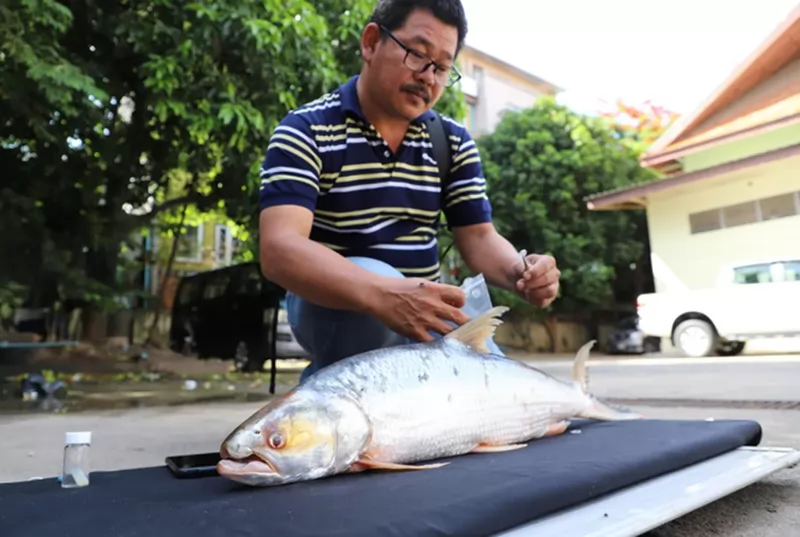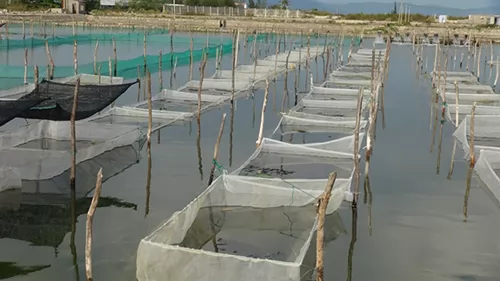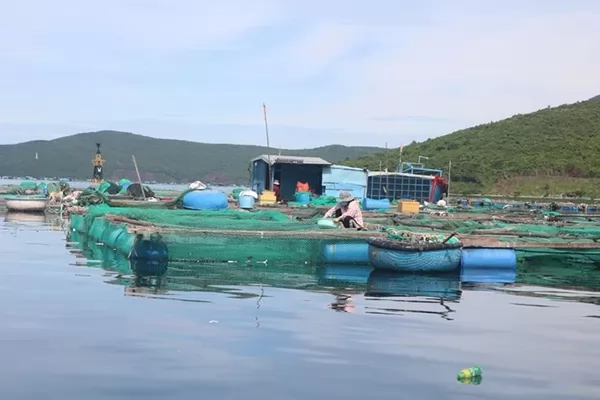Giant fish thought to be extinct is spotted in the Mekong River

The giant salmon carp has been rediscovered in Cambodia.
(VAN) A huge fish in the Mekong River thought to be extinct has been spotted three times in recent years.
When scientists heard reports that a large, mysterious fish had been caught in Cambodia in 2020, excitement stirred. Could this be the “Mekong Ghost,” they asked - an elusive fish that hadn’t been seen since 2005 and was feared extinct?
Photos of the fish and its telltale identifiers – an odd-shaped mouth and a protruding knob at its jaw – seemed to confirm it.
But the fish, which can grow as large as 66 pounds, was sold before scientists could get a closer look. It didn’t “feel like definitive proof,” said Zeb Hogan, a research biologist at the University of Nevada, Reno, and head of the US government-funded Wonders of the Mekong project, an initiative to study and conserve one of the most biodiverse rivers in the world.
Three years later, they struck gold.
Cambodian fishermen caught two fish in the Mekong River, measuring between 11 and 13 pounds and two to three feet long. This time researchers were able to purchase and examine the fish for themselves.
“Even though the fishermen … hadn’t seen the fish before, they knew that they had something remarkable, unusual. They knew that it was worth contacting us,” said Hogan, part of an international team of scientists who work with the Cambodian fisheries department, in an interview with CNN.
“As soon as anyone who was part of this search for this fish saw the photos, we knew what it was.”
The researchers published their findings on Tuesday in a study in the Biological Conservation journal.
It was a moment of celebration for the team, which works to protect the Mekong, one of the world’s longest rivers and a lifeline to tens of millions of people.
Meaning “Mother of Rivers” in Thai and Lao languages, the Mekong winds through multiple Southeast Asian countries and is extremely rich in biodiversity. But it also faces various challenges including hydropower development, overfishing and habitat degradation.
These challenges are why scientists have long worried that the “Mekong Ghost,” a critically endangered giant salmon carp that can measure up to four feet long, could have been quietly wiped out as years passed without a sighting.
Shrouded in mystery
The fish, native to the Mekong, has been shrouded in mystery since it was formally named in 1991. Since then, fewer than 30 individuals have been recorded, making it a highly rare species, according to a press release from the University of Nevada, Reno.
Hogan’s team of researchers – who also study other species and parts of the Mekong’s environment – have kept an eye out for the giant salmon carp, perusing fish markets and doing outreach programs with local fishermen. Hogan himself, who has dedicated much of his career to studying fish in the Mekong River Basin, has only seen it once in the early 2000s.
“I’ve been looking for it since then, kind of fascinated by it because it’s a very unusual giant fish,” Hogan said. “I thought it was probably extinct, and so to hear that it had been found again – I’ve been waiting 20 years for that news.”
“It’s a sign of hope,” he added. “It means that it’s not too late.”
The study’s lead author, Bunyeth Chan from Cambodia’s Svay Rieng University, echoed this sentiment, saying in a press release: “The rediscovery of the giant salmon carp is a reason for hope, not just for this species but for the entire Mekong ecosystem.”
There’s a lot researchers still don’t know, like how many giant salmon carp actually exist or where those populations reside.
The three fish that were found between 2020 and 2023 were found outside their normal range – which could either mean there are more fish living in areas previously unknown or that they migrated there from neighboring Laos and Thailand.
And though it’s unusual to find three individual fish in quick succession after the species disappeared for nearly two decades, Hogan credits this to the work they’ve been doing on the ground – building good relationships with local communities who know to contact them if they spot anything out of the ordinary.
But researchers say more needs to be done as the Mekong fights off threats from various fronts, including climate change, with the region facing more severe flooding and drought each year as a result.
Human projects such as hydropower dams and sand mining have further degraded marine habitats and disrupted life for the Mekong’s more than 1,100 fish species, many of which are found nowhere else on Earth.
Nearly a fifth of the Mekong’s fish are threatened with extinction, according to a report released in March this year, a collaboration between 25 organizations including the World Wildlife Fund and Wonders of the Mekong.
Cambodia is also not an easy place to be an environmental activist. Many have been jailed or killed over the years as they seek to raise awareness about corruption and business projects that have impacted the environment in a nation where little political opposition is tolerated.
Earlier this year, 10 young activists from the group Mother Nature Cambodia were sentenced to up to six years in prison, each on charges of conspiring against the state, a conviction that was condemned by opposition politicians in exile and prominent youth environmentalist Greta Thunberg.
Researchers behind the latest report hope the giant salmon carp’s rediscovery can build momentum for more study and conservation action – including creating an international team across Cambodia, Laos and Thailand to further study the “Mekong Ghost.”
“This fish is an indicator of river health because it’s a large fish, it’s vulnerable,” said Hogan.
“But it’s also emblematic of all of these other fish that occur in the area that are key fishery species and that are very important for people’s livelihoods, and very important for people’s nutrition and food.”
H.D
(CNN)
Maybe you are interested

Green livestock farming trend: Effective use of biological products
Raising chickens using biological products is becoming increasingly popular in Tay Ninh. This method contributes to the safe, sustainable development of livestock farming and promotes environmental protection.

New sandfish farming model to be replicated
KHÁNH HÒA — The south-central coastal province of Khánh Hòa has successfully farmed sandfish with other aquatic species under a new model developed by the Research Institute for Aquaculture No 3 under the Ministry of Agriculture and Rural Development.

Solutions for sustainable growth of lobster farming
(VAN) In an interview with Vietnam Agriculture News, Tran Dinh Luan, director of the Directorate of Fisheries, proposed solutions for developing sustainable lobster farming in the South Central areas.





